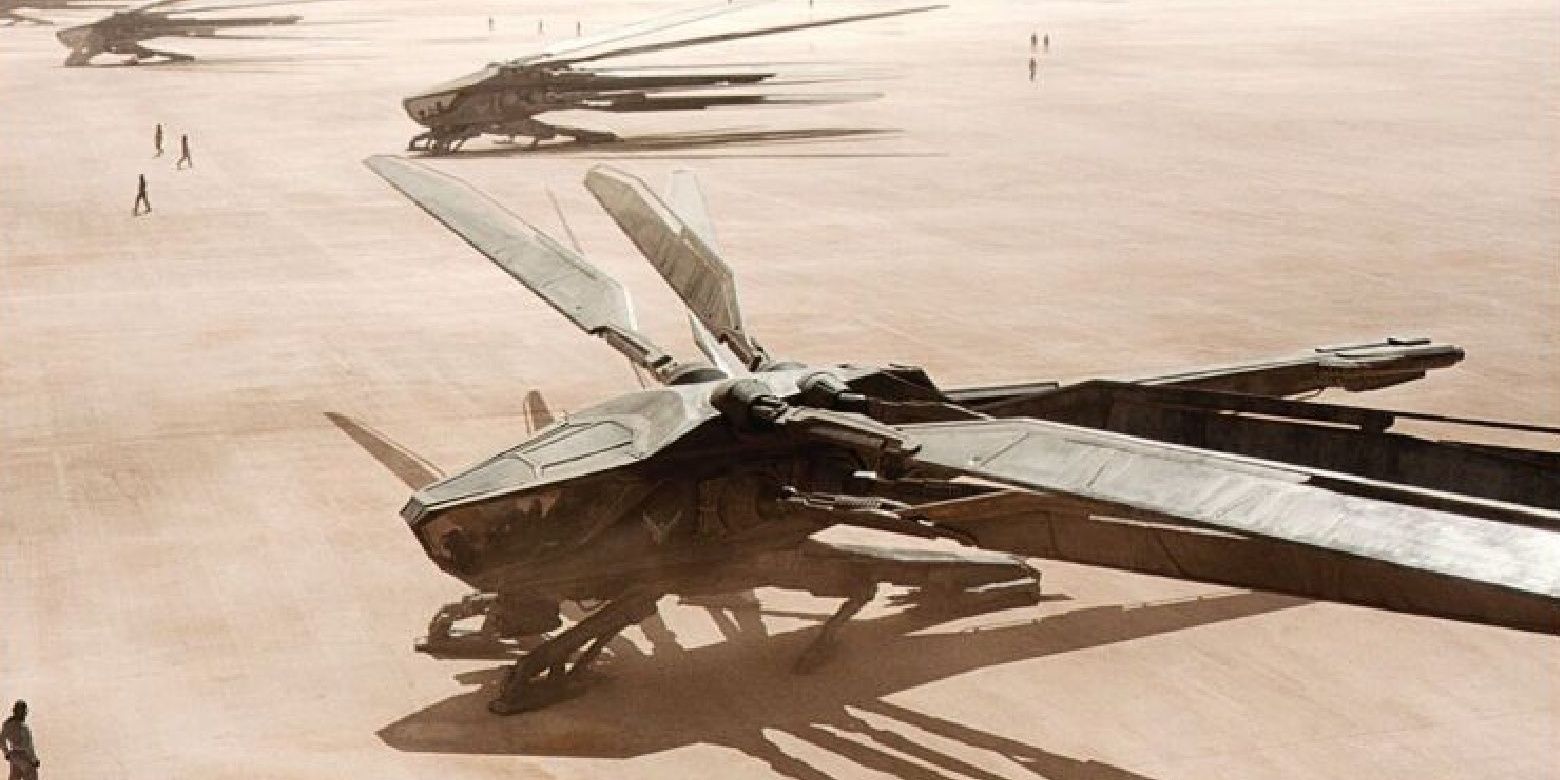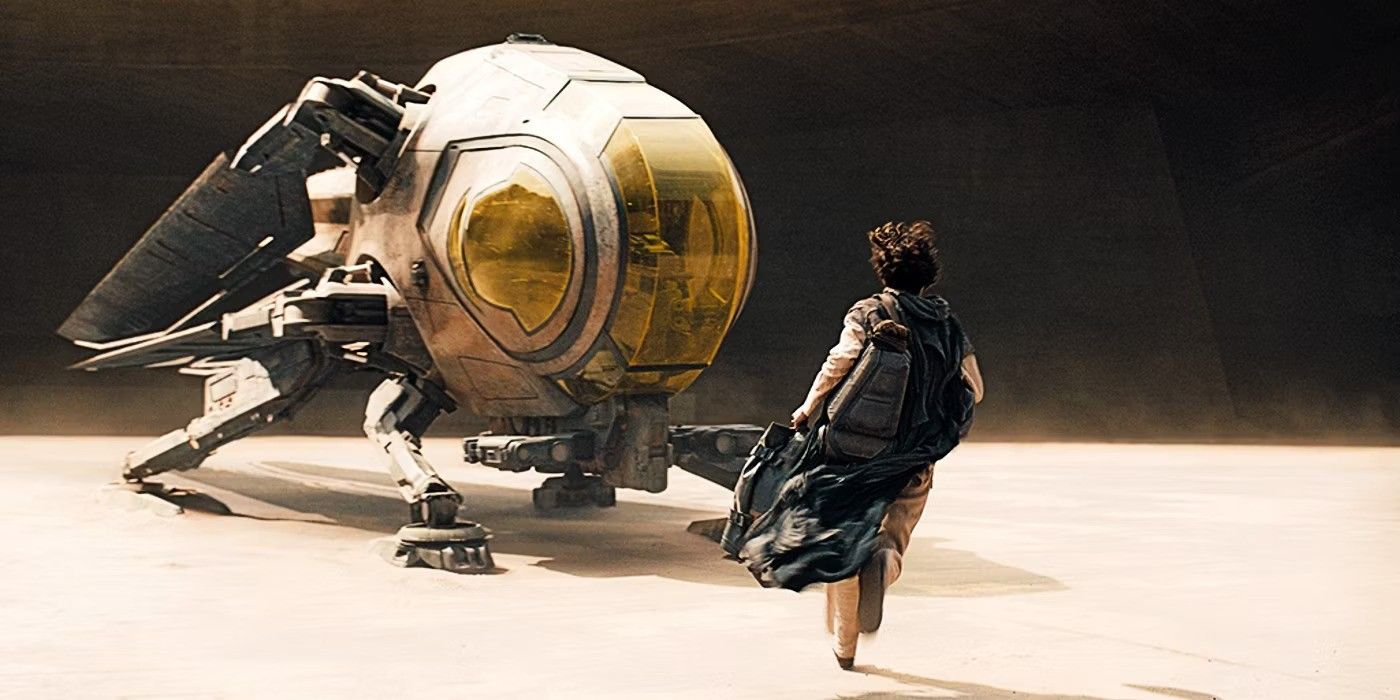The look of a science fiction universe can make or break it. Aesthetics aren't everything, but a unique design philosophy helps a story stand out. Dune is one of the best examples of fictional technological innovation. Dune is brilliantly inventive, from their Holtzman shields that keep the combat up close and personal to their stillsuits that keep survivors hydrated in the desert. The ornithopter is Dune's go-to aerial transport, and its bird-like flight makes it essential.
The upside of having multiple failed attempts at adapting a classic is that fans get to see the varied visions the source material inspired. Dune (2021) and its masterful sequel are stellar takes on Frank Herbert's 1965 classic. While previous efforts were inarguably less successful, they demonstrated the possibilities buried within the text. Denis Villeneuve nailed it with the power of modern special effects and the knowledge of those who came before.

February Is Your Last Chance To Watch Dune On Netflix
Denis Villeneuve's Dune is still on Netflix, but not for long. With Dune Part 2 arriving soon, now is the perfect time to watch it.
What are Ornithopters?
Ornithopters are aerial vehicles frequently used in planetary atmospheres. Though they can make short space flights, they're typically used more like airplanes than spaceships. Ornithopters, or 'thopters, can carry six comfortably or nine uncomfortably. The vehicles are armed, wielding laser, explosive, and spring-loaded weaponry. They employ shields, though doing so on Arrakis is dangerous. Ornithopters are built for various purposes, including cargo or personnel transport, guard duties, and sport racing. Their visual depictions vary wildly. Villeneuve's film adopted and perfected the most iconic design. It resembles a dragonfly with directly powered wings, multiple flight styles, and six-directional movement. Older examples mimic birds or bats, with a couple oddly reminiscent of fish. The 2001 PC game depicted them as modern jets, but it's an outlier.
Who created the ornithopter?
The original 1965 novel never outlined the ornithopter's creation, but The Dune Encyclopedia explains. That reference guide was released in 1984, and though it contradicts elements of later Dune sequels, it still features engaging details. According to the Encyclopedia, ornithopters were invented by a political prisoner named Jehane Golitle. Golite was part of an unsuccessful rebellion against Emperor Neweh. Most of the details have been lost to time. Golite led a team of scientists and fellow would-be freedom fighters under the Emperor's heel after failing to overthrow him. Golite had to continue inventing impressive gadgets to stay in the Emperor's good graces and avoid harm. After years of effort, Golite devised a large artificial aircraft with the flexibility of a bird. She created and tested the first ornithopter over five years.
Ornithopters didn't immediately seize the market. They represented a massive departure from existing aircraft that created a significant barrier to entry. While 'thopters were inarguably superior to fixed-wing planes or helicopters, their unique features created fear in existing structures. The first prominent use for ornithopters was personal sport flying. Ibrahim Holtzman, of Holtzman Effect fame, became a notable sporting pilot before crashing an early model. Some wealthy citizens bought them as commuter vehicles, but Emperor Neweh wanted them to become ubiquitous. Flight time didn't count towards a pilot's license for the first 40 years of their existence. They lived up to their potential after the Butlerian Jihad, the galaxy-wide war to eliminate thinking machines. Without AI autopiloting software, the ornithopter became an efficient new solution.
How do ornithopters work?
This question also varies based on its version. The Dune Encyclopedia explains with the most detail. That text states that ornithopters use a living being called a Heart Scallop for power. The Heart Scallop is a land mollusk that can weigh more than 300 pounds. It's a filter feeder that strains microorganisms through the air it breathes. Jehane Golite discovered the strength and flexibility of the Heart Scallop. She attached it to a set of flexible wings, creating an engine that requires no fuel. Two electrical lines activate and deactivate the bivalve, switching between fixed-wing and bird-like flight. This concept never comes up in the original novel. Duneand its sequels describe a jump jet that uses flexible wings to hover and control itself in midair. Paul describes his 'thopter like this:
He broke off as the Duke kicked on the jet brakes. The ship bucked as its tail pods whispered to silence. Stub wings elongated, cupped the air. The craft became a full 'thopter as the Duke banked it, holding the wings to a gentle beat, pointing with his left hand off to the east beyond the factory crawler.
The ornithopter is an excellent design element of the Dune universe. It does little to further the narrative, but it doesn't have to. Dune frames much of its story with brilliant narrative devices. The Holtzman Shield, for example, creates a futuristic excuse for a world in which knife fighting remains the dominant problem-solving tool. The ornithopter simply fills the need for an aerial vehicle, but it does so with the creative flair fans expect from a classic.

Dune: Caladan, Explained
Before they migrated to the unforgiving deserts of Arrakis, House Atreides spent 10,000 years on the beautiful world of Caladan.




